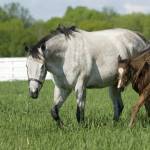White Thoroughbreds: Where Did They Come From?

Bays, chestnuts, dark brown horses, gray horses…coat colors in almost any solid shade are commonly seen in Thoroughbreds. Much less common for the breed are horses that display a white or mostly white coat. Historically, there have been so few white Thoroughbreds that many people are under the mistaken impression that horses with this coat color can’t be registered with The Jockey Club.
Actually, horses of Thoroughbred breeding that appear to have white or mostly white coats can be registered. Truly white equines are still rare; most have a few darker hairs sprinkled in, and in past years these were usually registered as gray or roan horses. Gray horses often appear black as young foals, gradually morphing through steel gray to light gray to almost pure white as they age. Roan coat coloring includes an even intermixing of white hairs within the darker coat.
Patchen Wilkes Farm in Lexington, Kentucky is credited with registering the first white Thoroughbred, White Beauty, with The Jockey Club in 1963. Since then, the farm has produced several other white Thoroughbred foals among crops of more traditionally colored youngsters. Most of these foals had some small areas of chestnut coloring that often covered the poll and ears in a “medicine hat” pattern.
Genetic research conducted in the 1960s showed that these horses were not albinos and had not been produced by accidental matings with non-Thoroughbred sires, but no one had an explanation as to where the aberrant coloring originated. Theories included outcrops of rare recessive genes carried by the sire and dam, or some sort of environmental effect that had caused a mutation.
Advances in genetic analysis have provided some answers to coat color questions that could not be successfully solved when White Beauty was born. According to Samantha Brooks, Ph.D., an assistant professor of equine genetics at Cornell University, spontaneous mutations on a gene known as KIT are probably responsible for the white or mostly white color. The mutations can cause a range of coat colors including pure white and predominantly white with some brown patches or ticking. About 20 mutations are known to occur on this gene, some of which are dominant, meaning that affected horses can pass the color on to their offspring when mated to a horse of any other color.
Though their striking appearance gets them a lot of attention if these horses enter the racing industry, white Thoroughbreds as a group have not enjoyed great success on the track. However, at least one white Thoroughbred has been drafted for a film career, taking the part of the Lone Ranger’s horse Silver.








